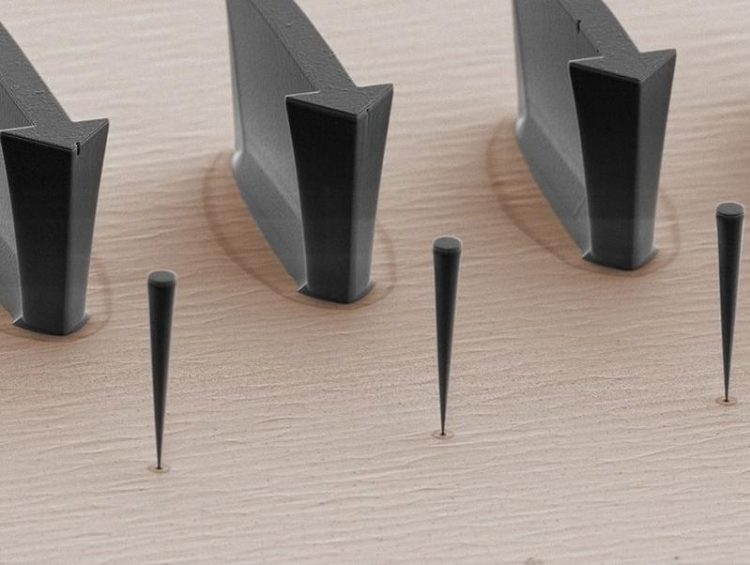Coupling a Nano-trumpet With a Quantum Dot Enables Precise Position Determination

Trumpet-shaped nanowires with a length of about 10 micrometers are coupled to quantum dots located at their bases. Grenoble Alps University
Professor Richard Warburton and Argovia Professor Martino Poggio’s teams in the Department of Physics and the Swiss Nanoscience Institute at the University of Basel worked with colleagues from Grenoble Alps University and the Alternative Energies and Atomic Energy Commission (CEA) in Grenoble to couple a microscopic mechanical resonator with a nano-scale quantum dot.
They used nanowires made of gallium arsenide that are about 10 micrometers long and have a diameter of a few micrometers at the top. The wires taper sharply downwards and therefore look like tiny trumpets arranged on the substrate. Near the base, which is only about 200 nanometers wide, the scientists placed a single quantum dot that can emit individual light particles (photons).
Excitations lead to strains
If the nanowire oscillates back and forth due to thermal or electrical excitation, the relatively large mass at the wide end of the nano-trumpet produces large strains in the wire that affect the quantum dot at the base. The quantum dots are squeezed together and pulled apart; as a result, the wavelength and thus the color of the photons emitted by the quantum dot change.
Although the changes are not particularly large, sensitive microscopes with very stable lasers – specifically developed in Basel for such measurements – are capable of precise detection of the wavelength changes. The researchers can use the shifted wavelengths to detect the motion of the wire with a sensitivity of only 100 femtometers. They expect that by exciting the quantum dot with a laser, the oscillation of the nanowire can be increased or decreased as desired.
Potential uses in sensor and information technology
“We are particularly fascinated by the fact that a link between objects of such different sizes is possible,” says Warburton. There are also various potential applications for this mutual coupling. “For example, we can use these coupled nanowires as sensitive sensors to analyze electrical or magnetic fields,” explains Poggio, who is investigating the possible applications with his team.
“It may also be possible to place several quantum dots on the nanowire, to use the motion to link them together and so pass on quantum information,” adds Warburton, whose group focuses on the diverse use of quantum dots in photonics.
Artificial atoms with special properties
Quantum dots are nanocrystals, and are also known as artificial atoms because they behave similarly to atoms. With a typical extent of 10 to 100 nanometers, they are significantly larger than actual atoms. Their size and shape, as well as the number of electrons, can vary. The electrons’ freedom of movement in the quantum dots is significantly restricted; the resulting quantum effects give them very special optical, magnetic and electrical properties. For example, quantum dots are able to emit individual light particles (photons) after excitation, which can then be detected using a tailor-made laser microscope.
Original source
Mathieu Munsch, Andreas V. Kuhlmann, Davide Cadeddu, Jean-Michel
Gérard, Julien Claudon, Martino Poggio, and Richard J. Warburton
Resonant driving of a single photon emitter embedded in a mechanical oscillator
Nature Communications (2017) | DOI: s41467-017-00097-3
Further information
Richard Warburton, University of Basel, Department of Physics, Tel. +41 (0)61 207 35 60, email: richard.warburton@unibas.ch
https://www.unibas.ch/en/News-Events/News/Uni-Research/Coupling-a-Nano-trumpet-W…
Media Contact
All latest news from the category: Physics and Astronomy
This area deals with the fundamental laws and building blocks of nature and how they interact, the properties and the behavior of matter, and research into space and time and their structures.
innovations-report provides in-depth reports and articles on subjects such as astrophysics, laser technologies, nuclear, quantum, particle and solid-state physics, nanotechnologies, planetary research and findings (Mars, Venus) and developments related to the Hubble Telescope.
Newest articles

NASA: Mystery of life’s handedness deepens
The mystery of why life uses molecules with specific orientations has deepened with a NASA-funded discovery that RNA — a key molecule thought to have potentially held the instructions for…

What are the effects of historic lithium mining on water quality?
Study reveals low levels of common contaminants but high levels of other elements in waters associated with an abandoned lithium mine. Lithium ore and mining waste from a historic lithium…

Quantum-inspired design boosts efficiency of heat-to-electricity conversion
Rice engineers take unconventional route to improving thermophotovoltaic systems. Researchers at Rice University have found a new way to improve a key element of thermophotovoltaic (TPV) systems, which convert heat…



